The Effect of A Kernel Sentence Combining Technique on the Reading Comprehension Levels of Basic English Students at UPR-Cayey
By: David H. Luciano
University of Puerto Rico At Cayey
Department of English
Abstract
In Puerto Rico English is taught as a second language (ESL), and it is a compulsory subject from the elementary level all the way up to high school graduation, yet many college freshmen are classified as low English proficient (LEP), as evidenced by the results in their College Entrance and Examination Boards (CEEB).The purpose of this study was to investigate and analyze how the implementation of the Kernel-Sentence-Combining Technique (the treatment) helped Basic English students at UPR-Cayey to improve their reading comprehension levels. The participants were 44 first year students enrolled in Basic English (INGL 3101-02). There was an experimental (26 participants) as well as a control group (18 participants), the experimental group received a six-week treatment with the kernel-sentence-combining technique. The data were gathered with an instrument that included: a self-made reading comprehension test, a self-made maze-cloze test, and a self-made language proficiency test. The study followed a quantitative approach applying descriptive statistics to the data. The findings include that the Kernel-Sentence-Combining Technique helps students to improve their reading comprehension levels, and that the maze-cloze test is a better measuring instrument for assessing reading comprehension levels in ESL students.
Key Words: sentence-combining, reading comprehension, quasi-experiment, maze-cloze test
Introduction
Teaching English as a second language in Puerto Rico is not an easy task. Educators are constantly searching for better techniques and methods for making the teaching-learning process not only enjoyable but at the same time rewarding. And rewarding means that the students learn and acquire the language in all of the four language arts modes: listening, speaking, reading and writing, also that they learn how to appreciate and value the importance and need for learning a second language. Reading allows for the other three modes of the language arts to be taught in context. This has put a pressure on educators because students are tested every year to measure their reading comprehension levels. Standardized tests have become the norm for evaluating student progress and also if educators are being successful in the teaching-learning process. The almost thirty years of teaching experience has allowed this researcher to conclude that the students get bored while learning a second language. Therefore, new and/or existing techniques that have been researched and implemented to help native English speakers with their academic achievement could also be researched and experimented with ESL students to prove their validity in helping them improve their reading comprehension levels.
One technique that has yielded positive results with improving reading comprehension levels was first proposed by Neville and Searls (1985) known as the Kernel Sentence Combining Technique, they conducted a study with Native English speakers. The difference from their study and the one conducted here is the target population. Now it has been conducted with ESL Basic students in Cayey, Puerto Rico. One problem is that these students come with a very limited schemata (prior knowledge) and they rely on a bottom-up model of processing what they see on the text. Schema theory was first proposed in 1932 by the Cambridge memory researcher Sir Frederic Bartlett (Field, 2003). According to schema theory, the process of interpretation is guided by the principle that every input is mapped against some existing schema and that all aspects of that schema must be compatible with the input information (Carrell, & Eisterhold, 1983, p556). They also assert that there are two basic modes of information processing, called bottom-up and top-down. The bottom-up model of processing means that the student depends more on learning and understanding what is in the text as opposed to a top-down model in which the schemata, experience and knowledge of the target language play an important role.
According to Bloomfield and Barnhart (1961) the bottom-up model is a reading model that emphasizes the written or printed text. It stipulates that the meaning of any text must be “decoded” by the reader and that students are reading when they can “sound out” words on page (phonics). In this model of reading letters are transformed into phonemic representations, these representations are transformed into words. The words are then assigned meaning which are then combined into sentences. Finally, meaningful associations are formed and stored.
For this reason and due to the nature of the setting in which ESL students in Puerto Rico try to learn the second language like mentioned before, educators are constantly searching for new methods and techniques that will improve their students’ academic achievement. The kernel-Sentence-Combining-Technique is one of those techniques that has improved the teaching-learning process. Sentence-Combining has its roots in the generative transformational theory of grammar as developed by Chomsky (Cook, 1996). Two particular aspects of generative-transformational theory led to the initial research in sentence-combining: Chomsky’s hypothesis of two levels of language, surface structure and deep structure, and his description of the ways in which these two structures were related through transformations. One of these transformations is the rule, of joining two propositions so as to embed one in the other. This is what is called sentence-combining.
Additionally, sentence-combining practice and reading comprehension has been made more tenable because of the widespread acceptance of the psycholinguistic model of reading comprehension, which has identified syntactic knowledge as one of the three basic competencies underlying the act of reading (Goodman, 1969, Smith 1971, 1975, as cited in Neville, Searls, 1985).
Furthermore, the implementation of the Kernel Sentence-Combining technique is one more effort towards helping students in acquiring English as a second language. To be specific it is used for improving reading comprehension; it helps students become better readers. And by becoming better readers they will understand what they read and thus their motivation and self-esteem will improve as a result.
The purpose of this research was to investigate and analyze how the Kernel-Sentence-Combining Technique can help Basic English students (INGL 3001-3102) at UPR-Cayey improve their reading comprehension levels. The design for this research is a quasi-experimental pre-post test design. The population for this research are Basic English students at UPR-Cayey (taught by the researcher), thus the sampling was chosen nonrandom by convenience. There is an experimental group as well as a control group. The main variables included in this research are the independent variable which is the Kernel-Sentence-Combining Technique (V1) and the dependent variable which is reading comprehension (V2). The experimental group received a six-week treatment (independent variable) whereas the control group continued to work with the regular curriculum from the course. The data gathering instrument consists of a self-made reading comprehension test, a self-made maze-cloze test, and a self-made language proficiency test. The findings of this research were analyzed using descriptive statistics.
Research Questions
This study has been guided by the following question:
- Is the Kernel- Sentence-Combining Technique an effective way of teaching reading comprehension?
- Is the Kernel- Sentence-Combining Technique a more effective way of teaching reading comprehension than the current methodology used with Basic English students at UPR-Cayey?
Hypotheses
Ho
There is no significant difference between Basic English students who are taught reading comprehension by means of a methodological emphasis on a Kernel-Sentence-Combining Technique and Basic English students who are taught reading comprehension by means of the current reading methodology.
H1
There is significant difference between Basic English students who are taught reading comprehension by means of the methodological emphasis on a Kernel- Sentence-Combining Technique and Basic English students who are taught reading comprehension by means of the current reading methodology
Review of Literature
This research was guided by many research studies including Bundrick (1988) who successfully used the sentence-combining technique with students. Bundrick and his colleagues wrote an article titled The Effects of Sentence-Combining Instructions on Writing and on Standardized Test Scores. The results indicated that strong gains had been registered by the experimental group. The findings include that sentence-combining instruction most influences the reading and writing development tests of such skills. Coban (1976, cited in Evan 1986) concurs that reading achievement and writing effectiveness correlated among capable students with their mastery of a broad variety of syntactic structures used in their speaking and writing repertoire. As a consequence, the integration of traditional and transformational sentence-combining instructional strategies influences high school students as dramatically and as exclusively as instruction in sentence combining. And that sentence-combining most sensitively distinguishes between, and measures gains among, the reading and writing skills of those students who begin such instruction with lowest skills in those areas. Overall, the bond between syntactic constructions in reading and writing has been reconfirmed and possibly more particularized by these studies.
Joseph Fusaro conducted a study which he titled: A Meta-Analysis of the Effect of Sentence-Combining on Reading Comprehension. The results of this study indicate that sentence-combining had a beneficial effect on reading comprehension when the criterion measure was cloze tests[u13] . A cloze test is a reading comprehension test in which every nth word is deleted in a passage. For higher education it is every 7th word, the reader needs to supply the missing elements. The difference in the maze-cloze test is that for every nth word of the passage that is deleted the reader has alternatives to choose from (3 or 4 ) for filling the blanks (Deno, Espin, & Shin, 2000).
For the purpose of this research a maze-cloze test was used to assess student’s progress because as already mentioned these are ESL students with very little or no background knowledge.
There is also evidence of the relationship of sentence-combining and reading comprehension. There is widespread acceptance of the psycholinguistic model of reading comprehension, which has identified syntactic knowledge as one of the three basic competencies underlying the act of reading (Goodman, 1971, cited in Grabe, 1991).
Now here is where another challenge arises. It is very hard to determine if there was gain in the reading comprehension levels through a standardized reading test. This means that the best way of measuring reading comprehension may be through a cloze test. (Neville & Searls, 1985). Donald Neville and Evelyn Searls (1985) conducted a study titled: The Effect of Sentence-Combining and Kernel Identification Training on the Syntactic Component of Reading Comprehension. The purpose of this study was to investigate the effects of a combination of Sentence-Combining and Kernel-Identification Training on Sixth grade students’ performance on two Test of Reading Comprehension subtests purported to measure syntactic knowledge and on a cloze test emphasizing structural words.
The researchers concluded that sentence-combining and kernel-identification training enabled the experimental group to comprehend longer syntactically more complex sentences and to exhibit a tendency toward retention of this ability over a 6-week period, since they were post tested on a delayed period of six weeks after the treatment. And they also concluded that the cloze test seemed to be sensitive to the training given while the standardized test was not.
Similarly, other researchers have concluded that the maze-cloze test reliably assesses student growth in reading (Deno, Espin, & Shin, 2000). Jongho Shin, Stanley Deno, and Christine Espin in their study titled: Technical Adequacy of the Maze Task for Curriculum-Based Measurement of Reading Growth examined the technical adequacy of curriculum-based measurement (CMB) for assessing student growth over time. The study revealed that the maze task reliably assesses student’s growth in reading based on repeated performance measures collected at intervals from one (1) to three (3) months over an academic year. For the purpose of this research as already mentioned the maze-cloze task has been used as one of the instruments to measure reading comprehension. The rationale for using a maze-cloze test instead of the traditional cloze-test is because these students are ESL students, thus their prior knowledge (schemata) is very limited.
Going back to the fact that the subjects are ESL Basic English students, these are students who have completed high school in the public or private schools of Puerto Rico and are first year college students. But it also means that their native or first language (L1) is not English but Spanish. Here is where comprehension takes center stage; (Coady, 1979, as cited in Grabe, 1991) suggested a model in which the ESL reader’s background knowledge interacts with conceptual abilities and process strategies more or less successfully to produce comprehension. Grabe (1991) in his article Current Developments in Second Language Reading Research indicates that both reading research and practice have undergone numerous changes in the past twenty-five (25) years since TESOL was first established. The purpose of his article is to bring together research and its implications for the classroom. Current reading research follows from certain assumptions on the nature of the reading process; these assumptions are reviewed, and general perspectives of the reading process are presented, such as the comments made by Coady (1979). Grabe (1991) states for example that fluent reading is rapid, purposeful, interactive, comprehending, flexible, and gradually developing. And also, that reading means comprehending which signifies that the reader typically expects to understand what he/she has read. Going back to Coady (1979), conceptual ability refers to intellectual capacity; processing strategies refers to various subcomponents of reading ability such as grapheme-morphophonemic correspondences, syllable-morpheme information, syntactic information (deep and surface structure), lexical meaning, and contextual meaning; and background knowledge refers to what the reader brings to the reading task (Coady,1979). This is also called schema and it is a very important aspect in the comprehension of reading by ESL students. Especially if these students come from a background in which their only, or almost only contact with English is inside the classroom.
Good readers identify group of words within the sentence that convey meaning (Hafner, Palmer, 1980). In their study titled The Differential Effects of Three Methods of Teaching on the Reading Comprehension and Vocabulary of Ninth Grade Students their purpose was to determine the differential effects of two methods of teaching reading comprehension and one method of teaching vocabulary on the reading comprehension achievement and vocabulary of ninth-grade students.
The results indicate that the two successful teaching strategies delineated in the report should be added to the list of tools that may be used for improving students’ reading comprehension, vocabulary, and speed of reading comprehension. The findings also indicate that there are no sex differences in reading comprehension, speed of reading, or vocabulary. Also, that the ability to identify sentence kernels, aids reading comprehension and the author’s hypotheses that logically analyzing cognitive relationships in reading material improves vocabulary and facets of reading comprehension are substantiated by the finding of the present study. This study is another example of the type of research conducted for the purpose of his research project. The goal of this research was to prove that utilizing the technique of sentence-combining will improve reading comprehension levels in the experimental group as opposed to the control group that will not receive the treatment. In this study ninth graders are the subjects. For the purpose of this research Basic English students at UPR-Cayey are the subjects or participants.
The technique of presenting kernel or pieces of a sentence separated in order for the reader to identify better those meaningful groups of words is part of the strategy that this research project implemented with these ESL students. Sentence-Combining is an effective tool for improving not only the reading comprehension skills, but also the writing skills of students in their article The effect of grammar teaching [Sentence-Combing] in English on 5 to 16 years olds’ accuracy and quality in written composition Richard Andrews and Graham Low, concluded that sentence-combining is an effective tool for improving the syntactic maturity of students in English between the ages of 5 to 16.
Adapted to second language learning it is also important to note that many people start to learn a second language (L2) but few, if any, manage to gain knowledge of the L2 equivalent to that of the L1. One possible explanation for this is the interference of the first language. This means that these L2 learners already have or possess a set of rules and principles (Universal Grammar) from their L1 (Chomsky, 1976, cited in Cook, 1996). Taking this into consideration and the fact that the schema (prior knowledge) plays an important role in second language learning, reading comprehension was measured through a self-made test. The important part of this test is the maze-cloze test which is a variation of the cloze-test. In this case it was adapted to be used with ESL students whose background knowledge of the L2 is not enough for completing a normal cloze test. In the maze-cloze test the alternatives are given for each deleted word, so it is easier for them to fill the blanks.
Through these studies the sentence-combining technique is easier to understand. And there is enough evidence that the use of this technique is good for improving reading and writing skills. And it is a good technique for ESL students who are low in such skills. Some of these studies are also evidence that a cloze-test is a good tool for measuring reading comprehension and as already mentioned in the case of this research a maze-cloze test is better suited for ESL students.
Methodology
First, the Institutional Review Board (IRB) granted permission for conducting the research, due to the fact that the Quasi-experiment’s participants are human subjects. Also, the students consented to participate in the study. Confidentiality is assured by stating that no names are to be used for the purpose of the results and publication, in other words, the identity of the participants will be protected by ensuring anonymity.
The second step is to pre-test the students in order to pick the two most homogeneous groups for the research. Homogeneity here refers to the results in the scores on the pre-test related to reading comprehension levels and language proficiency in ESL. These two groups will later become the experimental group and control group. This has been achieved through the results gathered from the pre-test administered at the beginning of the semester. These two groups are placed in an envelope in order to determine at random which group is the experimental and which one is the control group. The control group had 18 students and the experimental group had 26 students. The next step is to administer the pre-post test to the control as well as the experimental group this is known as the measuring instrument. It is an instrument made by the researcher. The textbook Weaving It Together: Connecting Reading and Writing 4 (4th Edition) currently used with Basic English students was used for the test’s material. This instrument consists of a self-made reading comprehension test, a self-made maze-cloze test, and a self-made language proficiency test. Then the next step is the participation of the experimental group in the 6-week treatment with the independent variable of the kernel sentence-combining technique. The control group receives the class as scheduled in the syllabus. After the 6-week treatment the students of both control and experimental groups are post-tested using the same measuring instrument.
The findings of this research were analyzed using descriptive statistics. Descriptive statistics are used to describe the basic features of the data in the study (Trochim, 2002). These statistics in conjunction with graphical analyses form the basis of every quantitative analysis of data. According to Trochim (2002), descriptive statistics are used to present quantitative descriptions in a manageable form, in other words a large number of people can be measured on any measure. All of the statistics and graphics of this research were computed utilizing the Microsoft Excel program.
Results and discussion
The purpose of this research was to prove that the Kernel-Sentence-Combining Technique (treatment, independent variable) helps English as Second Language (ESL) students to improve their reading comprehension levels. The null hypothesis stated that there is no significant difference between ESL students who are taught reading comprehension by means of a methodological emphasis on a kernel-sentence-combining technique and ESL students who are taught reading comprehension based on the regular curriculum used with basic English students at UPR Cayey, in mean gain-scores measured by a self-made reading comprehension test, a self-made maze-cloze test, and a self-made language proficiency test. The following are the figures and tables with the results from the Quasi-experiment:
Figure 1- Mean scores of the instruments on the pre-post tests –Experimental Group
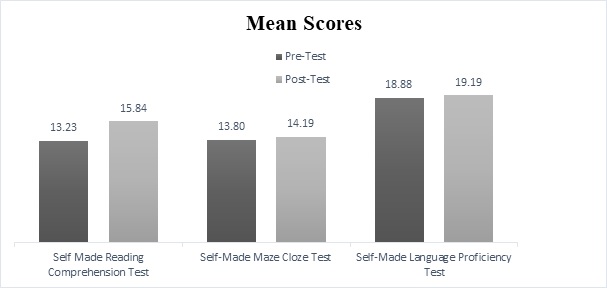
Figure 1 shows the mean scores of the pre and post tests for the three (3) measuring instruments. This data is for the experimental group. The self-made reading comprehension test has mean scores of 13.23 and 15.84 for the pre and post tests, respectively. The self-made maze-cloze test shows mean scores of 13.80 and 14.19 for the pre and post tests, respectively. And the self-made language proficiency test shows mean scores of 18.88 and 19.19 for the pre and post tests, respectively. These data indicate an increase in mean for all three measuring instruments.
Figure 2- Mean scores of the instruments on the pre-post tests –Control Group
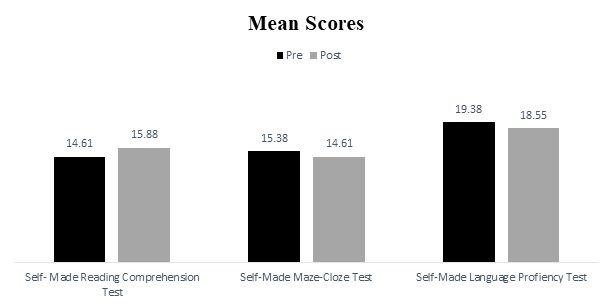
Figure 2 shows the means scores of the pre and post tests for the three (3) measuring instruments. This data is for the control group. The self-made reading comprehension test has mean scores of 14.61 and 15.88 for the pre and post tests, respectively. The self-made-maze-cloze test has mean scores of 15.38 and 14.61 for the pre and post tests, respectively. And the self-Made language proficiency test has mean scores of 19.38 and 18.55 for the pre and post tests, respectively. These data indicate an increase in mean only for the self-made reading comprehension test, and in the other two tests there was a decrease in means.
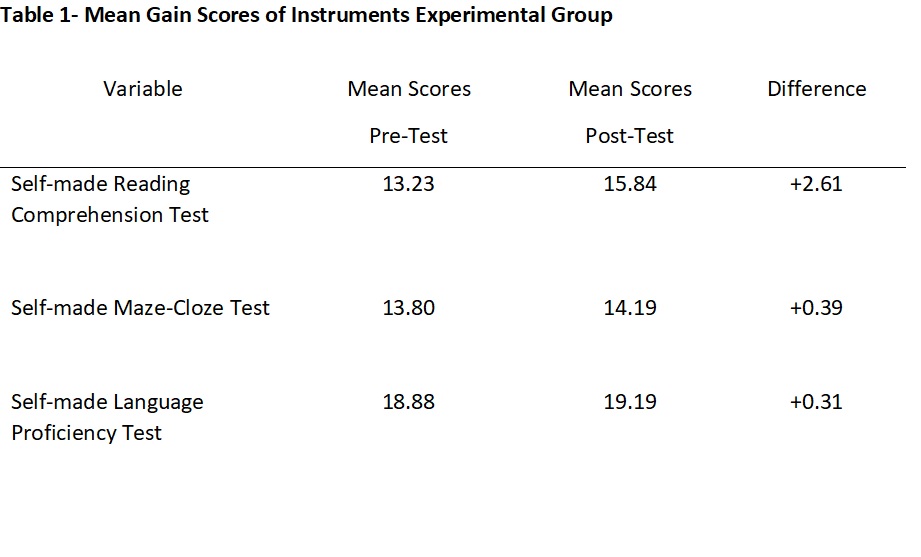
Table 1 shows the mean gain scores of the pre and post tests of the instruments for the experimental group. First the self-made reading comprehension test, here the data show a mean gain scores of 13.23 on the pre-test, and 15.84 in the post-test. Second is the self-made maze-cloze test, here the data show mean gain scores of 13.80 and 14.19 for the pre and post tests, respectively. Third is the self-made language proficiency test here the data show mean gain scores of 18.88 and 19.19 for the pre and post test, respectively. Each of these tests shows an increase in mean gain scores of +2.61, +0.39, and +0.31 for the self-made Reading Comprehension, self-made Maze-Cloze, and self-Made Language Proficiency tests, respectively.
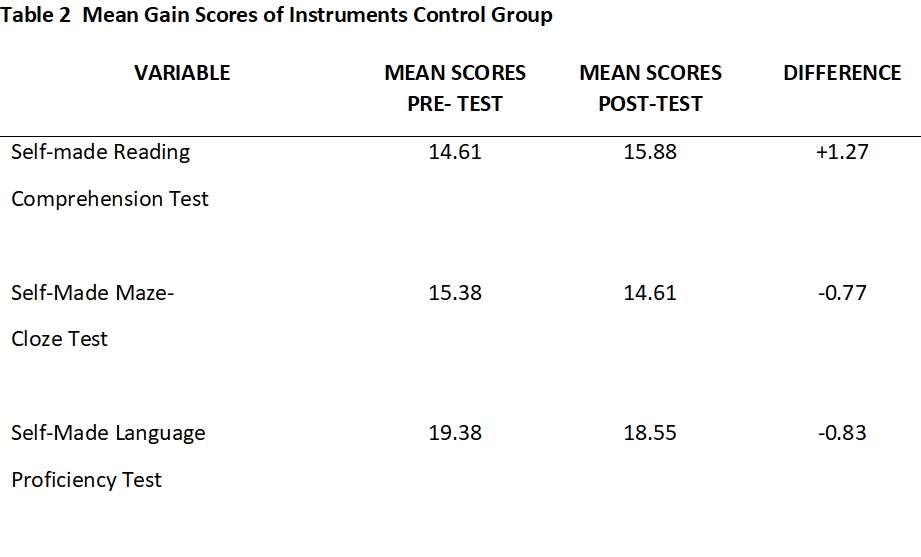
Table 2 shows the mean gain scores of the pre and post tests of the instruments for the control group. First the self-made reading comprehension test, here the data show a mean gain scores of 14.61 on the pre-test, and 15.88 in the post-test. Second is the self-made maze-cloze test, here the data show mean gain scores of 15.38 and 14.61 for the pre and post tests, respectively. Third is the self-made language proficiency test here the data show mean gain scores of 19.38 and 18.55 for the pre and post tests, respectively. Only the self-made reading comprehension test shows an increase in mean scores of +1.27. The other two tests show a decrease in mean scores of -0.77 and -0.83 for the self-made maze-cloze and the self-made language proficiency tests, respectively.
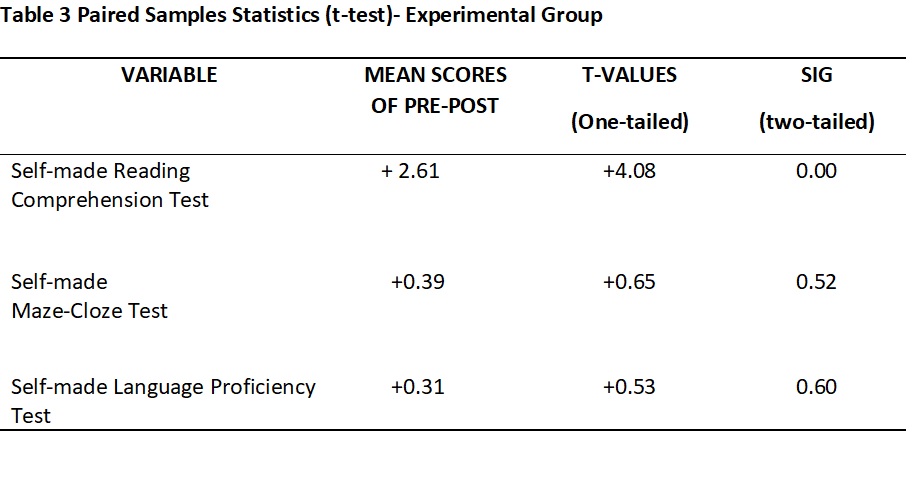
Table 3 shows the paired samples statistics (t-test) for the pre-post tests of the experimental group. First the data shows the self-made reading comprehension test in which the mean difference score is +2.61, with a t-value of +4.08 and a significance of 0.00. Second, for the self-made maze-cloze test the mean difference score is +0.39, with a t-value of +0.65 and a significance of 0.52. Third is the self-made language proficiency test in which the mean difference is +0.31 with a t-value of +0.53 and a significance of 0.60. The confidence interval is 95% (p < .05).
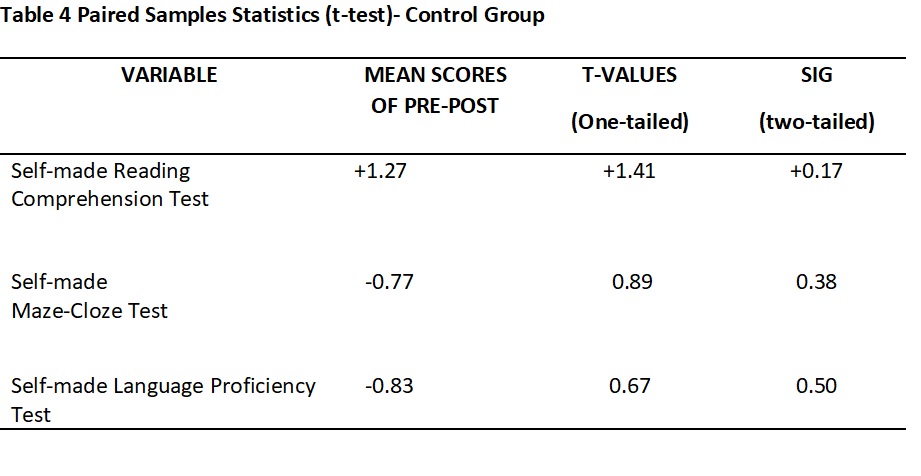
Table 4 shows the paired samples statistics (t-test) for the pre-post tests of the control group. First the data show the Self-made reading comprehension test in which the mean difference score is +1.27, with a t-value of +1.41 and a significance of +0.17. Second, for the Self-made maze-cloze test the mean difference score is -0.77, with a t-value of 0.89 and a significance of 0.38. Third is the self-made language proficiency test in which the mean gain is -0.83 with a t-value of 0.67 and a significance of 0.50. The confidence interval is 95% (p < .05).
Conclusions
This research project has found evidence that the Kernel-Sentence-Combining Technique is effective in helping ESL students to improve their reading comprehension levels as evidenced by the figures and tables presented in the results and discussion section above. This was also concluded by Neville and Searls (1985) in their study titled: The Effect of Sentence-Combining and Kernel-Identification Training on the Syntactic Component of Reading Comprehension, with native speakers of English.
It is also important to notice that the material used for the treatment (Kernel-Sentence-Combining Technique) was suitable and adapted for ESL students. The reason for this is that experts such as Goodman (1971) as cited in Grabe (1991); Coady (1979); and Grabe (1991) have all concurred that the background knowledge (schemata) in other words what the student brings to the classroom is essential for comprehension to take place. All the lessons used during the six (6) week treatment were adapted for ESL learners. Hafner and Palmer (1980) in their study titled: The Different Effects of Three Methods of Teaching on the Reading Comprehension and Vocabulary of Ninth Grade Students also concluded that the ability to identify sentence Kernel, aids reading comprehension. In their article entitled: The Effect of Grammar Teaching (Sentence Combining) in English on 5 to 16 years olds’ accuracy and quality in written comprehension the conclusion reached is that sentence-combining is an effective tool for improving reading comprehension skills. Again, the main difference in this study is that it was conducted with ESL college students in Puerto Rico.
Another important conclusion is the use of measuring instruments which are suitable for the level and characteristics of the participants. Joseph Fusaro conducted a study titled: A Meta-Analysis of the Effect of Sentence-Combining on Reading Comprehension, in which he concluded that sentence-combining had a beneficial effect on reading comprehension when the criteria measure was a cloze test (Fusaro, 1992, p.228). Other researchers have concluded that the maze-cloze test reliability assesses student growth in reading (Deno, Espin, & Shin, 2000). In this research project the participants were ESL students who depended mostly on what they found on the text (bottom up model of reading) as opposed to bringing their background knowledge (schemata) to the reading experience (Bloomfield and Barnhart, 1961). This is why a self-made maze-cloze test was used instead of the traditional cloze-test as one of the measuring instruments.
Finally, it can be concluded after analyzing the data and as shown in the figures and tables presented in the results and discussion section above that the null hypothesis H0 is rejected in favor of the alternative hypothesis H1, (see tables 3 and 4 in the results and discussion section)which states that there is significant difference between Basic English students who are taught reading comprehension by means of the methodological emphasis on a Kernel-Sentence-Combining Technique and Basic English students who are taught reading comprehension by means of the current reading methodology of the regular curriculum.
Implications and Recommendations
At the offset of the study it becomes obvious the need for teachers, instructors and professors to experiment with new techniques. One such technique is the Kernel-Sentence-Combining Technique. This technique proved effective in helping basic ESL students to improve their reading comprehension levels. It is recommended that this same study be replicated adding more groups at this same level, and with elementary and secondary level students. Another implication of the research project is that reading in a second language (L2) is different from reading in a first language (L1). Noam Chomsky tried to adapt the Language Acquisition Device (LAD) model to second language (L2) learning (Cook, 1996). But it is obvious that people who start to learn an L2 rarely manage to gain knowledge equivalent to the L1. This is why it is important for educators to take a stand and conduct research with new or proven techniques in order to help their ESL students with their reading and writing skills.
Consequently, it is important for educators to adapt their material to the needs of their ESL students who have very little if any prior knowledge (schemata). That is why it is also recommended to use the maze-cloze test as a measuring instrument as opposed to the traditional cloze-test. Neville and Searls (1985) concluded that the cloze test was better for measuring reading comprehension as opposed to a regular standardized test. Fusaro (1993) concluded that sentence-combining had a beneficial effect on reading comprehension when the criterion measure was cloze tests. It is important to mention that in this research all three instruments: the self-made reading comprehension test, the self-made maze-cloze test and the self-made language proficiency test, yielded positive results when measuring reading comprehension levels for the experimental group (see Figure 1 and Table 1 above).
References
Andrews, R., & Low, G. (2004). The effect of grammar teaching [Sentence-Combing] in English on 5 to 16 years olds’ accuracy and quality in written composition. Research Gate, Retrieved September 20, 2020, from file:///C:/Users/dhluc/Downloads/Andrewsetal.-Systematicreviewonsentence- combining2004.pdf
Bundrick, M. Evans, R., & McWilliams, E. (1988, September/October). The effect of sentence- combining instructions on writing and on standardized test scores. Journal of Educational Research, 82(1) 53-57.
Carrell, P., & Eisterhold, J. (1983). Schema theory and ESL reading pedagogy. Tesol Quarterly, 17(4) 553-573.
Chomsky, N. (1986). Knowledge of language: its nature, origin and use. New York: Sager Publishers.
Chomsky, N. (1975). The logical structure of linguistic theory. Chicago and London: The University of Chicago Press.
Coady, J. (1979). A psycholinguistic model of the reader. Reading in a second language. 2(1) 1-10.
Combs, W. (1977, July/August). Sentence-combining practice: Do gains in judgments of writing quality persist? Journal of Educational Research, 70(6) 318-321.
Cook, V., & Newson, M. (1996). Chomsky’s universal grammar: An introduction (2nd ed.). Malden, Ma: Blackwell Publishers Inc.
Creswell, J.W. (2014). Research design: Qualitative, quantitative, and mixed methods approaches. (4th ed.).London: Sage Publications.
Dean, D. (August 2008). Sentence combining: Building skills through reading and writing. Classroom Notes Plus. Retrieved March 7, 2017 from: http://www.ncte.org/pubs/journals/cnp/issues
Deno, S., Espin, C, & Shin, J. (2000, Fall). Technical adequacy of the maze task for curriculum-based measurement of reading growth. The Journal of Special Education, 3 4(3) 164-172.
Doherty, R. W. (2005). Evaluation report of the NEAL/REDE Chicago initiative. Santa Cruz Center for Research on Education, Diversity & Excellence, University of California. Retrieved December 9, 2008 from Wilson Web database on the worldwide web: http://biblioteca,urrp.edu:2071.
Field, J. (2003). Psycholinguistics: A resource book for students. London: Routledge.
Gaur, A., & Gaur, S. (2009). Statistical methods for practice and research: A guide to data analysis using SPSS. India: Sage Publications.
Grabe, W. (1991). Current developments in second language reading research. Tesol Quarterly, 25 (3) 375-405.
Goodman, Y., Watson, D., & Burke, C. (1996). Reading strategies: focus on comprehension. (2nd ed). New York. Richard C. Owen Publishers, Inc.
Gribbons, B., Herman, J. (1997). True and quasi-experimental designs. Practical
Assessment, Research & Evaluation, 5 (14). Retrieved August 16, 2009, from: http://ericae.net/pare/getun.asp?v=5bn=n14
Fusaro, J. (1993, winter). A meta-analysis of the effect of sentence-combining on reading comprehension. Reading Improvement, 30(4) 228-231.
Hafner, L., & Palmer, B. (1980, September/October). The differential Effects of three methods of teaching on the reading comprehension and vocabulary of ninth grade students. Journal of Educational Research, 74(1) 34-37.
Heilman, A.W., Blair, T.R. & Rupley, W.H. (1998). Principles and practices of teaching reading. Upper Saddle River, NJ: Merrill.
Hernández Sampieri, R., Fernández Collado, C., & Baptista Lucro, P. (2010). Metodología de la investigación (5ta ed.). McGraw Hill Interamericana Editores, S.A. México.
Kruger, A. (2000, summer). A meaning-based ESL reading program. Reading improvement, 37 (2) 50-55.
Neville, D., & Searls, E. (1985, February). The effect of sentence-combining and Kernel- identification training on the syntactic component of reading comprehension. Research in the Teaching of English, 19, 37-61.
Rumelhart, D. (1984). Understanding Reading Comprehension. Newark, Delaware. International Reading Association, Inc.
Siegle, D. (2005). Convenience sampling. Retrieved September 28, 2010, from http://gifted.uconn.edu/siegle/research/samples/convenience.htm
Steinman, L. (2002, December). Considering the cloze. Canadian Modern Language Review, 59(2) 291-301.
Strong, W. (1994). Sentence combining: A composing book. (3rd ed.). McGraw-Hill, Inc.
Trochim, W. (2002). Sampling. Retrieved March 4, 2017, from: http://www.ssc.wisc.edu/~oliver/SOC357/Lectures%20and%20Notes/Sampling Slides.pdf.
Trochim, W. (2002). Descriptive Statistics. Retrieved March 8, 2009, from: http://trochim.human.cornell.edu/kbstat_t.thm
Trochim, W. (2002). Quasi-experimental design. Retrieved March 4, 2017, from: http://www.socialresearchmethods,net/kb/quasiexp.htm
Ya-Ting, C., & Heng-An Chou (2003). Beyond Critical thinking skills: Investigating the relationship between central thinking skill and dispositions through online instructional strategies. British Journal of Educational Technology, 39(4), 666-684.
Trackback from your site.




